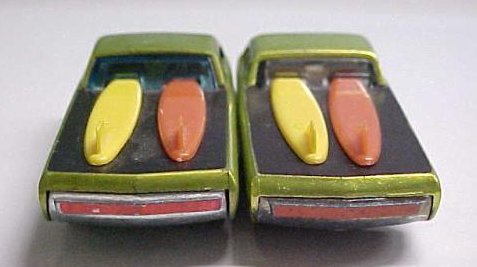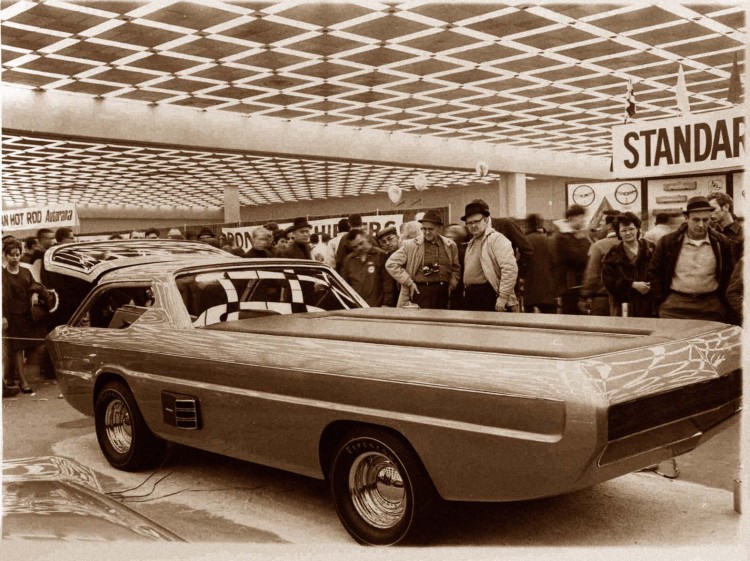The Deora - Alexander Brothers
 The Deora - Alexander Brothers
The Deora - Alexander Brothers
The 1967 Dodge Deora concept was closely based on the Dodge A-100 pickup truck, a popular and quirky-looking light pickup that would end production when the B-vans were launched in 1971. The Deora kept the A-100’s slant six engine, boosting power by using an Offenhauser intake manifold that supported dual carburetors, though the setup is tame in comparison to Chrysler’s older Hyper-Pak setup (it is believed to have roughly the same power as the 225 slant six). The van had a three-speed manual gearbox, four-wheel drum brakes, and solid front and rear axles supported by semi-elliptic leaf springs. It rode on a 90 inch wheelbase.
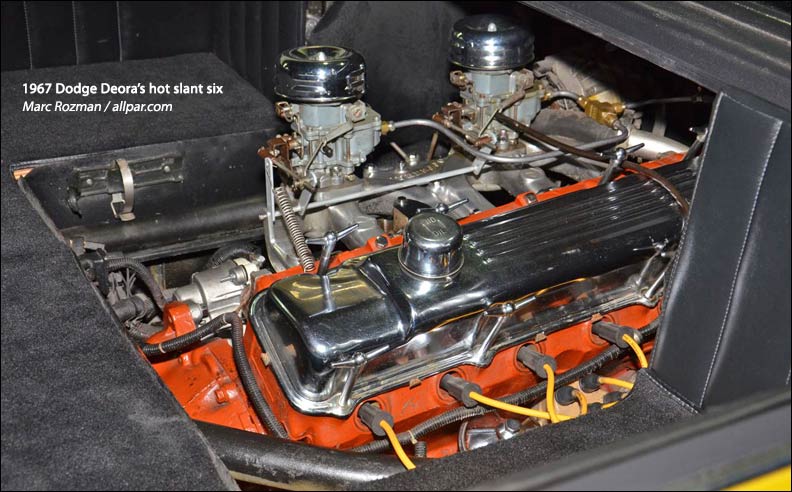
While the exterior was completely reworked, it is still somewhat recognizable as a Dodge A-100, but it had a more modern and racier look, pointed like an arrow to the road ahead. The Deora was conceived and built by Detroit’s Alexander brothers (Mike and Larry), with a high level of workmanship throughout (which is evident in the photos.) Design work was done on commission by GM’s Harry Bentley Bradley.
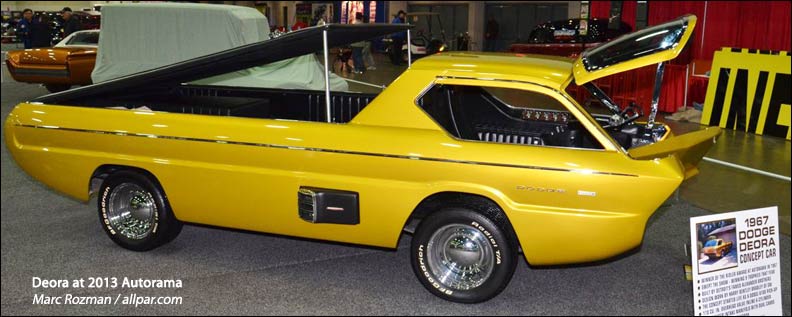
The car won the Ridler Award at the 1967 Autorama, and was the prototype for a Hot Wheels car and a model kit. The car was sold to its current owners in 2009.
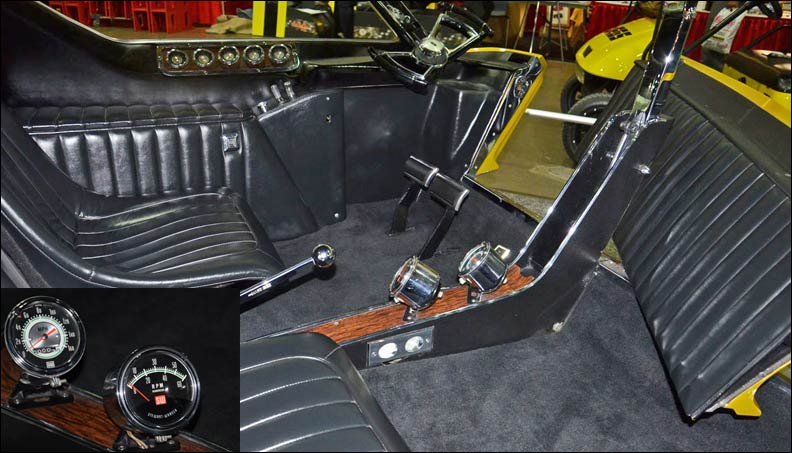
To build the Deora, the Alexander brothers moved the powertrain 15 inches towards the rear, putting it into the bed where it was concealed by the hard tonneau cover. There were no doors; the driver and passenger lifted up the windshield (taken from the rear hatch of a 1960 station wagon) and swivelled the front metal to provide clearance. Cleaning the interior was likely much easier than in conventional pickups.

The name Deora came from a naming contest for the plastic model kit. It was leased by Chrysler for two years and shown in the corporate displays, across the country, at various car shows. Al Davis bought it from Chrysler and put it into storage until 1998, when he asked Bradley, the original designer, to help restore it. The car’s post-restoration debut was at the 2002 Detroit Autorama.

The interior is unusual for a truck in the 1960s, when such niceties as a heater and passenger seat were still sometimes optional. However, Chrysler started an early push to make pickups into personal vehicles, from the 1957 “car-like” styling of the Sweptsides to the “adult toys” of the mid-1970s. The Deora fit right in, with its tasteful Stewart Warner gauges in woodgrain pods on the left side of the driver and in the center console (which held the tachometer and speedometer).

Putting the gauges to the left and right of the driver, which while classy looking was hardly a practical approach, was done mainly because entry and exit was done by pivoting the front metal, which would have made wiring and cabling rather difficult. For the same reason, the steering wheel was on a swing arm, so it could be moved out of the way. That said, the car did have a power opening windshield.
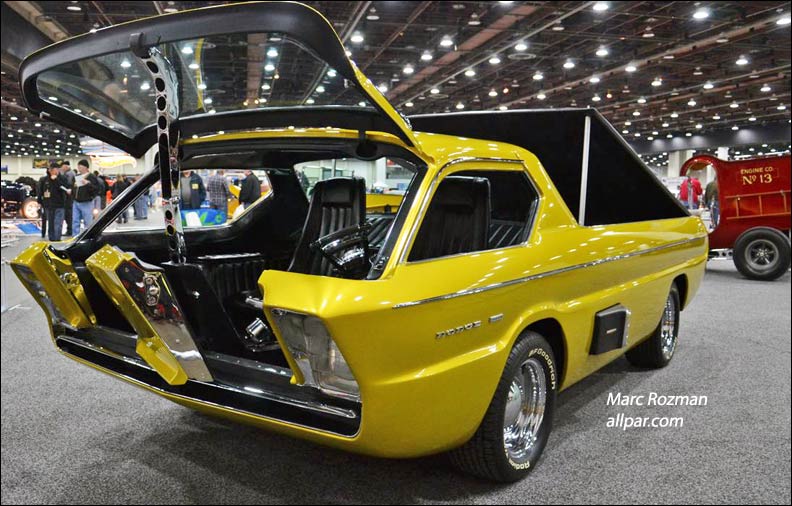
The were, according to Nick Taylor, mounted vertically, pointing down, and reflect in a solid metal panel. The panel that holds the lights has tiny holes for them to shine through, but you can’t see that without looking from underneath.
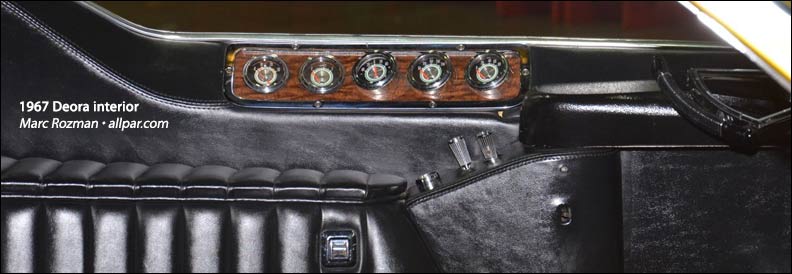
http://www.allpar.com/cars/concepts/dodge/deora.html
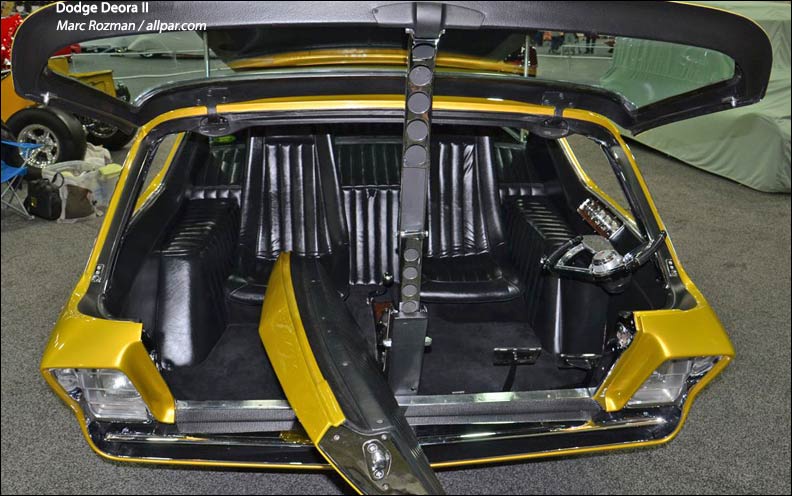

While the exterior was completely reworked, it is still somewhat recognizable as a Dodge A-100, but it had a more modern and racier look, pointed like an arrow to the road ahead. The Deora was conceived and built by Detroit’s Alexander brothers (Mike and Larry), with a high level of workmanship throughout (which is evident in the photos.) Design work was done on commission by GM’s Harry Bentley Bradley.

The car won the Ridler Award at the 1967 Autorama, and was the prototype for a Hot Wheels car and a model kit. The car was sold to its current owners in 2009.

To build the Deora, the Alexander brothers moved the powertrain 15 inches towards the rear, putting it into the bed where it was concealed by the hard tonneau cover. There were no doors; the driver and passenger lifted up the windshield (taken from the rear hatch of a 1960 station wagon) and swivelled the front metal to provide clearance. Cleaning the interior was likely much easier than in conventional pickups.

The name Deora came from a naming contest for the plastic model kit. It was leased by Chrysler for two years and shown in the corporate displays, across the country, at various car shows. Al Davis bought it from Chrysler and put it into storage until 1998, when he asked Bradley, the original designer, to help restore it. The car’s post-restoration debut was at the 2002 Detroit Autorama.

The interior is unusual for a truck in the 1960s, when such niceties as a heater and passenger seat were still sometimes optional. However, Chrysler started an early push to make pickups into personal vehicles, from the 1957 “car-like” styling of the Sweptsides to the “adult toys” of the mid-1970s. The Deora fit right in, with its tasteful Stewart Warner gauges in woodgrain pods on the left side of the driver and in the center console (which held the tachometer and speedometer).

Putting the gauges to the left and right of the driver, which while classy looking was hardly a practical approach, was done mainly because entry and exit was done by pivoting the front metal, which would have made wiring and cabling rather difficult. For the same reason, the steering wheel was on a swing arm, so it could be moved out of the way. That said, the car did have a power opening windshield.

The were, according to Nick Taylor, mounted vertically, pointing down, and reflect in a solid metal panel. The panel that holds the lights has tiny holes for them to shine through, but you can’t see that without looking from underneath.

http://www.allpar.com/cars/concepts/dodge/deora.html

_________________
We don't care the People Says , Rock 'n' roll is here to stay - Danny & the Juniors - 1958
 Re: The Deora - Alexander Brothers
Re: The Deora - Alexander Brothers
Unique 1965 Dodge Deora Concept going up for auction
Have you ever wanted to own your very own life-sized Hot Wheels car? Here's your chance! As part of RM's Icons of Speed and Style auction at the Petersen Automotive Museum on September 26, a 1965 Dodge Deora Concept will cross the block and go home with the highest bidder. Built by legendary hot rodders Mike and Larry Alexander, the one-off pickup truck won the Ridler Award at the 1967 Detroit Autorama and was immortalized a year later as one of the original 16 Hot Wheels model cars.

The unique design, based on a Dodge A100, includes no side doors but instead a forward-opening glass hatch that is essentially the back of a 1960 Ford station wagon turned 180 degrees. RM estimates that the Deora, which was restored to its original show specs just over ten years ago, should command between $350,000 - $550,000 when it goes up for auction. Follow the jump for more info on this unique showcar and how it came to be.
Vehicle Description Courtesy RM Auctions:
Spectacular!...that's the best single word description for the remarkable Dodge Deora. When people see this futuristic cab-forward pickup today, they're certain it's an AMT scale model or a "Hot Wheels" car come to life. But it was the other way around. Created as a spectacular one-off custom, this Ridler Award winner from the 1967 Detroit Autorama was adopted by Dodge Division of Chrysler Corporation, and became one of the company's most popular show cars. Created by one of hot rodding's premier designers, the Deora was handcrafted by two of the best custom car builders of all time.
Here's how it all happened:

Detroit's famed Alexander Brothers, Mike and Larry, won considerable acclaim with a customized Ford Victoria called, "The Victorian," and the "Silver Sapphire," Clarence "Chili" Catallo's unforgettable "Little Deuce Coupe," which appeared on the cover of Hot Rod magazine, and on the cover of the Beach Boys' album of the same name. In 1964, they wanted to build a "far-out" custom truck using one of the Big Three's new cabover mini-pickups. They tapped a talented friend, Harry Bentley Bradley, to design it. The "A Brothers" had discovered Harry when he was a student at Pratt Institute in New York City. They'd followed his career path to General Motors, where he apparently did freelance design work on the side.
The plan was simple. The Alexanders were certain that Dodge would give them a stock A100 truck to customize once they'd seen Harry's futuristic design sketches. And if Chrysler Corporation didn't bite, they would try Ford Motor Company, who'd just introduced their own Econoline cabover. Years later, Harry Bradley, who never pulled punches, told Motor Trend's writers, "Of the three cab-forward pickups on the market at the time, the Dodge was unquestionably the homeliest."
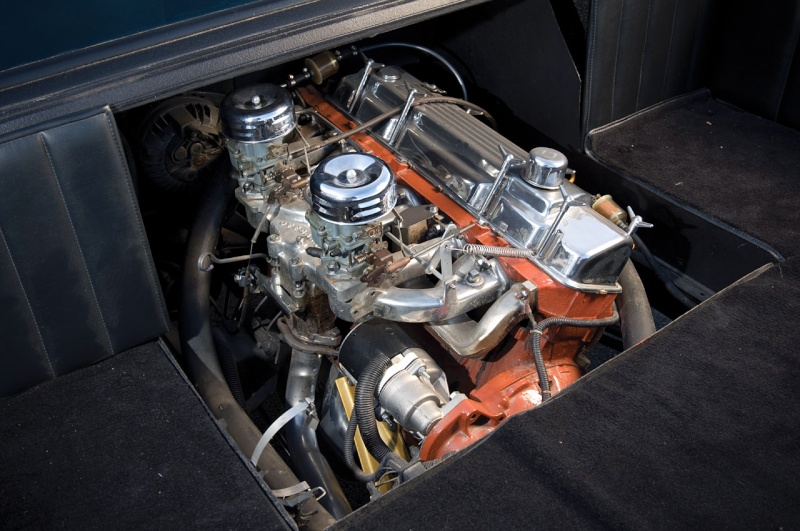
But Harry obviously saw something beautiful and decidedly avant-garde in the basic shape of the little cab-forward truck. "What I wanted to do," Bradley recalled, "was get rid of that phone booth cab and integrate the upper (section of the body) with the lower. The finished truck would have no doors on either side. "I didn't want cutlines," Bradley declared. "We were always told at GM to play down cutlines. If cutlines were wonderful," he continued, "Ferraris would have them running down their sides." Harry Bradley insists he always thought of this design "...as a conceptual proposal, rather than a customizing solution."
That left the practical problem-solving up to Larry and Mike Alexander. Just how would the driver and passenger get inside? The ingenious answer was through the front window, which in execution, became a large, forward-opening glass hatch that the clever "A Brothers" fabricated using the lift-up rear window from a donor 1960 Ford station wagon. More about that in a moment:

The Alexanders liked Harry Bradley's radical design. To everyone's surprise and delight, so did the powers that be at Chrysler, who donated a stripped A100 as a sacrificial lamb. Mike and Larry began by whacking off the stock cab completely, right down to the floorpan. When the new roof section was tack-welded into place, it rested just about where the stock steering column had been. Bradley's original vision was that the front-opening hatch would be a one-piece unit, hinged at the roof's leading edge, like the tailgate of a hatchback or the liftgate of a modern station wagon.
But the stock A100's flimsy A-pillars would never have supported that arrangement, so Mike and Larry ingeniously crafted a split door setup. The rear section of the 1960 Ford station wagon, rotated 180-degrees, became the new cab roof. What had been the Ford's rear window, was now the Deora's new windshield. Hinged at the top, it was controlled by an electric motor that activated an hinged arm that was plated for looks and drilled for lightness. The "A Bros" hand-fabricated a lower front panel that fit neatly between the headlights. That panel, which became the lower portion of the cab's only door, was hinged on the right side for ease of entry and exit.

Transforming Harry Bradley's futuristic sketches into a working trucklet took all the ingenuity the Alexanders possessed. They may have used a BMW Isetta for inspiration. The stock steering column was replaced with a folding horizontal strut that rotated forward from the left side of the body to let the driver in and out. It locked into place when the driver was seated. The steering wheel was a stylish butterfly-shaped yoke, reportedly made from an Oldsmobile steering wheel, which would have been right at home in a small aircraft.
The steering box itself is a modified Chevrolet Corvair unit. The vertical steering column runs up and out of sight through the left cab body panel. A small sprocket on top of the column is connected via a roller chain to another sprocket about 12 inches to the right, on the end of the swiveling bracket, which in turn, is connected to the steering wheel. A finger-operated latch mechanism locks the wheel in front of the driver. During entrance and egress, the steering column tilts forward so the driver can squeeze by. The stock A100 foot pedals were already mounted in the floor, so they didn't need to be relocated. Engineers at Hurst Performance Products developed a custom floor shifter for the stock Dodge three-speed manual transmission.
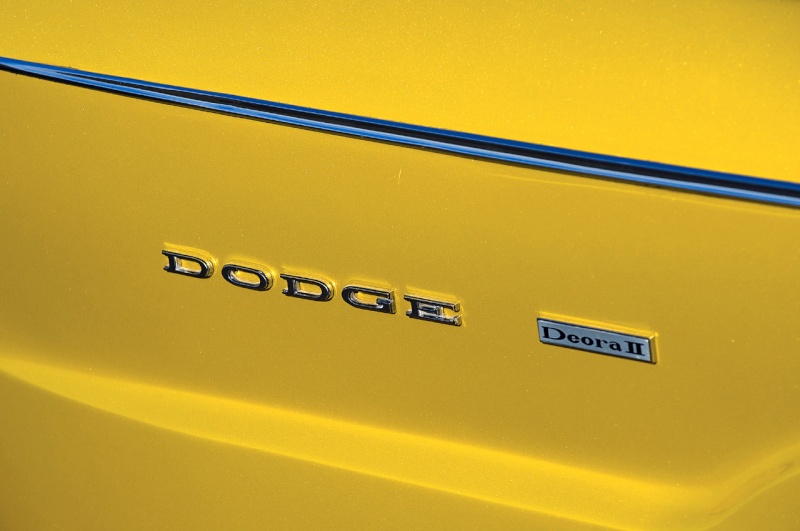
The Alexander brothers wanted the occupants to sit low, inboard of the front wheel wells, so the slant-six was moved rearward about 15 inches to make room for the bucket seats. The engine now protruded into the pickup bed, but the show truck was never really designed as a practical hauler, so it wasn't a problem. There was never a plan to stuff a big V-8 in this vehicle. Its sleek silhouette requirement would not have tolerated it.
In order to achieve that ultra-low look, the radiator was relocated in the bed as well, just ahead of the rear axle. Twin air intake holes were cut into the bottom of the bed, and an electric fan was used to draw in cooling air. That meant that the fuel tank had to be moved from its stock location behind the rear axle to a new position just behind the reconstituted cab. The pickup bed itself was covered with a hard tonneau that was secured by chrome hood locking pins, so no one could see the magic that went on beneath it.
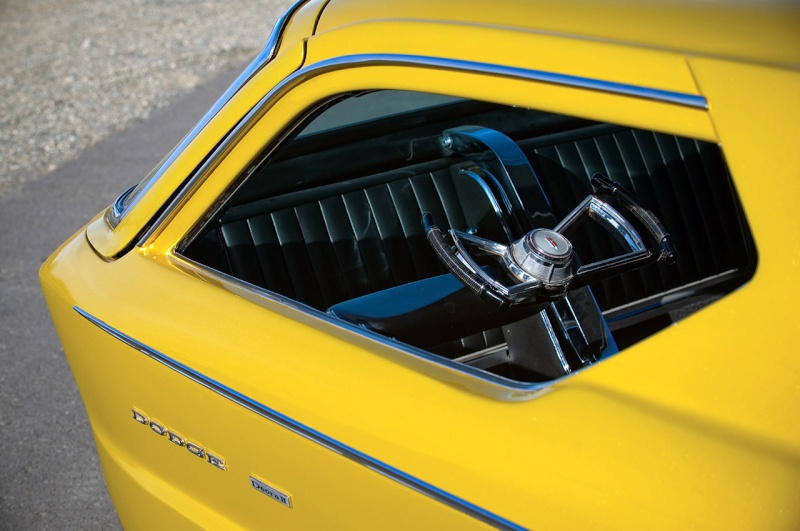
To effectively lower the chassis, the Alexander's raised the front frame rails and ran the front springs through the axle. Short-coupled industrial shocks replaced the original tubular shock absorbers in front. They also modified the rear suspension. The overall height of the truck went from about 72 inches in stock form, to just 57 inches after modifications – that's a 15 inch difference! Contoured bucket seats leaned rearward just a little to accommodate the Deora's two stylish occupants. The cockpit itself was trimmed in pleated leather. In keeping with this car's atypical design, the instrument panel was relocated to the driver's side door, and a center console held a speedometer and the tachometer.
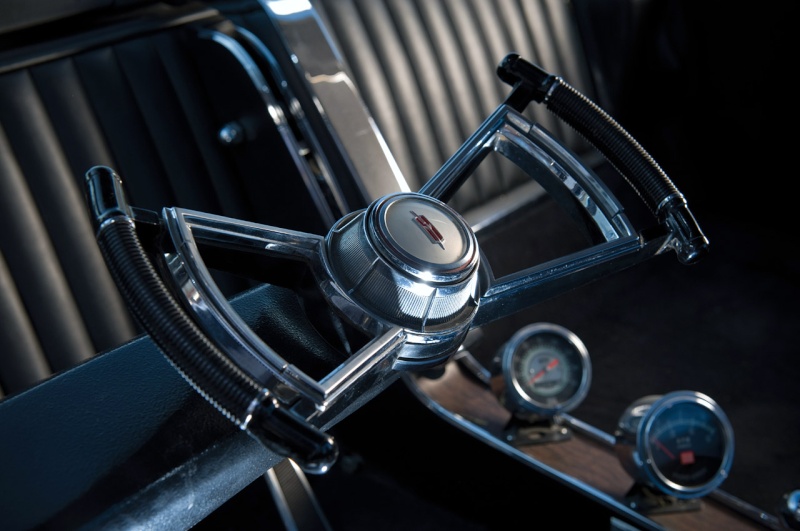
At the 1967 Detroit Autorama, the Deora completely swept the show, winning nine trophies plus the coveted Don Ridler award for the best new custom car. It was a poignant moment for Mike and Larry Alexander. Their father died on the morning of the Autorama setup day, but their mother convinced them that their Dad would have wanted the Deora to be shown. Interestingly, that was the only time the "A Brothers" ever showed the car in competition.
After the Deora was completed, Chrysler leased it to display on their auto show stands with their own concept cars, where it reportedly caused a sensation. Chrysler Corporation, who'd had nothing to do with the design save the donated A100 itself, claimed this car was a quantum leap in advanced vehicle styling. Today, over 40 years since it was first created, the Deora still resembles a car of the future. It should be noted that the remarkable mini-truck was conceived in an era where crumple zones and crash tests were unheard of, so there were no design compromises required for safety considerations. The cabin is small, but two adults can sit comfortably inside.
Jim Bradley told Motor Trend, "Chrysler never seemed to understand that we used (a lot of) Ford parts to build this car." Besides the 1960 Ford wagon tailgate and a small section of the station wagon's roof, the rear window was borrowed from a 1960 Ford sedan. And that's not all. 1964 ½ Mustang taillight bezels formed the surrounds for the twin side duct exhausts. The taillights are especially clever. Hidden under the wood veneer panel that runs across the rear, they are only visible when they're illuminated. Viewed from behind, the lights themselves are reflected in a polished stainless steel strip that runs underneath them. They were made from sequential turn signals found on a Ford Thunderbird. When the directionals are activated, the flashing lights blip outward from the center.
Not long after it debuted, the Deora became one of the first 16 "Hot Wheels" model cars offered to youngsters all over the country. Harry Bradley, who had left GM to join Mattel, noted Mattel's research in that era showed that every kid in America owned at least 1.3 miniature "Hot Wheels" cars. "I don't think many people knew the Deora was a real vehicle," he mused.
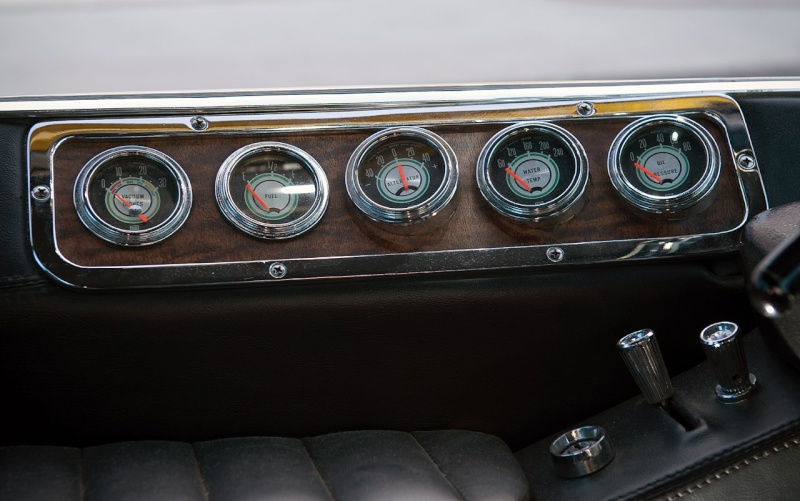
Rod & Custom actually tested the Deora in its September 1967 issue. Editor Spence Murray reportedly drove the car more miles in one afternoon than it had ever been driven, and he was very impressed. "Our test drive went off without a hitch," he reported. Larry Alexander knew that (the) Deora would perform up to the standards of any mass-produced pickup truck," Murray wrote. "But I had to prove it to myself."
After the first year's lease was up, Chrysler arranged to lease the Deora for a second year. They requested a new look for 1968, so it was repainted in Lime Green Pearl. After the second year, Chrysler did not renew its lease. The Deora was sold to Al Davis, a noted custom car enthusiast. Davis passed away in 1970. His son, Al Jr., stored the car for a while, then took it on the show circuit in 1982 and won a Championship. In 1998, the Deora was taken out of storage and re-restored to resemble its 1967 appearance. The Alexanders hadn't kept the paint formula, so it's believed the present color is a little "greener" than the original gold. The born-again Deora wowed 'em once again in 2002 at the 50th Anniversary of the Detroit Autorama, when it starred in a display of famous Alexander Brothers customs. Many people couldn't believe this car had been built over 40 years ago. It's still that good.
One final note: the unusual "Deora" name was chosen after AMT, the well-known model car manufacturers, held a contest to name the vehicle. The winning name was supposed to mean "gold" in Spanish. It was apropos because of the show car's original Candy Gold color. AMT's 1/25th scale model of the Deora was produced in great volume, but they're scarce collector's items today. Mattel's "Hot Wheels" sold millions of miniature Deoras in several colors. The Deora's winning bidder will receive extensive records on this car from the consignor, including copies of Harry Bradley's personal notes on its design.
Custom car aficionados agree, there's nothing like the Deora, and there never will be. If you loved this car as a model, imagine what it would be like to own the real thing?
RM Auctions would like to thank Thomas Voehringer and Angus MacKenzie, of Motor Trend, for portions of the research used in this description.
http://www.autoblog.com/2009/09/05/unique-1965-dodge-deora-concept-going-up-for-auction/
Have you ever wanted to own your very own life-sized Hot Wheels car? Here's your chance! As part of RM's Icons of Speed and Style auction at the Petersen Automotive Museum on September 26, a 1965 Dodge Deora Concept will cross the block and go home with the highest bidder. Built by legendary hot rodders Mike and Larry Alexander, the one-off pickup truck won the Ridler Award at the 1967 Detroit Autorama and was immortalized a year later as one of the original 16 Hot Wheels model cars.

The unique design, based on a Dodge A100, includes no side doors but instead a forward-opening glass hatch that is essentially the back of a 1960 Ford station wagon turned 180 degrees. RM estimates that the Deora, which was restored to its original show specs just over ten years ago, should command between $350,000 - $550,000 when it goes up for auction. Follow the jump for more info on this unique showcar and how it came to be.
Vehicle Description Courtesy RM Auctions:
Spectacular!...that's the best single word description for the remarkable Dodge Deora. When people see this futuristic cab-forward pickup today, they're certain it's an AMT scale model or a "Hot Wheels" car come to life. But it was the other way around. Created as a spectacular one-off custom, this Ridler Award winner from the 1967 Detroit Autorama was adopted by Dodge Division of Chrysler Corporation, and became one of the company's most popular show cars. Created by one of hot rodding's premier designers, the Deora was handcrafted by two of the best custom car builders of all time.
Here's how it all happened:

Detroit's famed Alexander Brothers, Mike and Larry, won considerable acclaim with a customized Ford Victoria called, "The Victorian," and the "Silver Sapphire," Clarence "Chili" Catallo's unforgettable "Little Deuce Coupe," which appeared on the cover of Hot Rod magazine, and on the cover of the Beach Boys' album of the same name. In 1964, they wanted to build a "far-out" custom truck using one of the Big Three's new cabover mini-pickups. They tapped a talented friend, Harry Bentley Bradley, to design it. The "A Brothers" had discovered Harry when he was a student at Pratt Institute in New York City. They'd followed his career path to General Motors, where he apparently did freelance design work on the side.
The plan was simple. The Alexanders were certain that Dodge would give them a stock A100 truck to customize once they'd seen Harry's futuristic design sketches. And if Chrysler Corporation didn't bite, they would try Ford Motor Company, who'd just introduced their own Econoline cabover. Years later, Harry Bradley, who never pulled punches, told Motor Trend's writers, "Of the three cab-forward pickups on the market at the time, the Dodge was unquestionably the homeliest."

But Harry obviously saw something beautiful and decidedly avant-garde in the basic shape of the little cab-forward truck. "What I wanted to do," Bradley recalled, "was get rid of that phone booth cab and integrate the upper (section of the body) with the lower. The finished truck would have no doors on either side. "I didn't want cutlines," Bradley declared. "We were always told at GM to play down cutlines. If cutlines were wonderful," he continued, "Ferraris would have them running down their sides." Harry Bradley insists he always thought of this design "...as a conceptual proposal, rather than a customizing solution."
That left the practical problem-solving up to Larry and Mike Alexander. Just how would the driver and passenger get inside? The ingenious answer was through the front window, which in execution, became a large, forward-opening glass hatch that the clever "A Brothers" fabricated using the lift-up rear window from a donor 1960 Ford station wagon. More about that in a moment:

The Alexanders liked Harry Bradley's radical design. To everyone's surprise and delight, so did the powers that be at Chrysler, who donated a stripped A100 as a sacrificial lamb. Mike and Larry began by whacking off the stock cab completely, right down to the floorpan. When the new roof section was tack-welded into place, it rested just about where the stock steering column had been. Bradley's original vision was that the front-opening hatch would be a one-piece unit, hinged at the roof's leading edge, like the tailgate of a hatchback or the liftgate of a modern station wagon.
But the stock A100's flimsy A-pillars would never have supported that arrangement, so Mike and Larry ingeniously crafted a split door setup. The rear section of the 1960 Ford station wagon, rotated 180-degrees, became the new cab roof. What had been the Ford's rear window, was now the Deora's new windshield. Hinged at the top, it was controlled by an electric motor that activated an hinged arm that was plated for looks and drilled for lightness. The "A Bros" hand-fabricated a lower front panel that fit neatly between the headlights. That panel, which became the lower portion of the cab's only door, was hinged on the right side for ease of entry and exit.

Transforming Harry Bradley's futuristic sketches into a working trucklet took all the ingenuity the Alexanders possessed. They may have used a BMW Isetta for inspiration. The stock steering column was replaced with a folding horizontal strut that rotated forward from the left side of the body to let the driver in and out. It locked into place when the driver was seated. The steering wheel was a stylish butterfly-shaped yoke, reportedly made from an Oldsmobile steering wheel, which would have been right at home in a small aircraft.
The steering box itself is a modified Chevrolet Corvair unit. The vertical steering column runs up and out of sight through the left cab body panel. A small sprocket on top of the column is connected via a roller chain to another sprocket about 12 inches to the right, on the end of the swiveling bracket, which in turn, is connected to the steering wheel. A finger-operated latch mechanism locks the wheel in front of the driver. During entrance and egress, the steering column tilts forward so the driver can squeeze by. The stock A100 foot pedals were already mounted in the floor, so they didn't need to be relocated. Engineers at Hurst Performance Products developed a custom floor shifter for the stock Dodge three-speed manual transmission.

The Alexander brothers wanted the occupants to sit low, inboard of the front wheel wells, so the slant-six was moved rearward about 15 inches to make room for the bucket seats. The engine now protruded into the pickup bed, but the show truck was never really designed as a practical hauler, so it wasn't a problem. There was never a plan to stuff a big V-8 in this vehicle. Its sleek silhouette requirement would not have tolerated it.
In order to achieve that ultra-low look, the radiator was relocated in the bed as well, just ahead of the rear axle. Twin air intake holes were cut into the bottom of the bed, and an electric fan was used to draw in cooling air. That meant that the fuel tank had to be moved from its stock location behind the rear axle to a new position just behind the reconstituted cab. The pickup bed itself was covered with a hard tonneau that was secured by chrome hood locking pins, so no one could see the magic that went on beneath it.

To effectively lower the chassis, the Alexander's raised the front frame rails and ran the front springs through the axle. Short-coupled industrial shocks replaced the original tubular shock absorbers in front. They also modified the rear suspension. The overall height of the truck went from about 72 inches in stock form, to just 57 inches after modifications – that's a 15 inch difference! Contoured bucket seats leaned rearward just a little to accommodate the Deora's two stylish occupants. The cockpit itself was trimmed in pleated leather. In keeping with this car's atypical design, the instrument panel was relocated to the driver's side door, and a center console held a speedometer and the tachometer.

At the 1967 Detroit Autorama, the Deora completely swept the show, winning nine trophies plus the coveted Don Ridler award for the best new custom car. It was a poignant moment for Mike and Larry Alexander. Their father died on the morning of the Autorama setup day, but their mother convinced them that their Dad would have wanted the Deora to be shown. Interestingly, that was the only time the "A Brothers" ever showed the car in competition.
After the Deora was completed, Chrysler leased it to display on their auto show stands with their own concept cars, where it reportedly caused a sensation. Chrysler Corporation, who'd had nothing to do with the design save the donated A100 itself, claimed this car was a quantum leap in advanced vehicle styling. Today, over 40 years since it was first created, the Deora still resembles a car of the future. It should be noted that the remarkable mini-truck was conceived in an era where crumple zones and crash tests were unheard of, so there were no design compromises required for safety considerations. The cabin is small, but two adults can sit comfortably inside.
Jim Bradley told Motor Trend, "Chrysler never seemed to understand that we used (a lot of) Ford parts to build this car." Besides the 1960 Ford wagon tailgate and a small section of the station wagon's roof, the rear window was borrowed from a 1960 Ford sedan. And that's not all. 1964 ½ Mustang taillight bezels formed the surrounds for the twin side duct exhausts. The taillights are especially clever. Hidden under the wood veneer panel that runs across the rear, they are only visible when they're illuminated. Viewed from behind, the lights themselves are reflected in a polished stainless steel strip that runs underneath them. They were made from sequential turn signals found on a Ford Thunderbird. When the directionals are activated, the flashing lights blip outward from the center.
Not long after it debuted, the Deora became one of the first 16 "Hot Wheels" model cars offered to youngsters all over the country. Harry Bradley, who had left GM to join Mattel, noted Mattel's research in that era showed that every kid in America owned at least 1.3 miniature "Hot Wheels" cars. "I don't think many people knew the Deora was a real vehicle," he mused.

Rod & Custom actually tested the Deora in its September 1967 issue. Editor Spence Murray reportedly drove the car more miles in one afternoon than it had ever been driven, and he was very impressed. "Our test drive went off without a hitch," he reported. Larry Alexander knew that (the) Deora would perform up to the standards of any mass-produced pickup truck," Murray wrote. "But I had to prove it to myself."
After the first year's lease was up, Chrysler arranged to lease the Deora for a second year. They requested a new look for 1968, so it was repainted in Lime Green Pearl. After the second year, Chrysler did not renew its lease. The Deora was sold to Al Davis, a noted custom car enthusiast. Davis passed away in 1970. His son, Al Jr., stored the car for a while, then took it on the show circuit in 1982 and won a Championship. In 1998, the Deora was taken out of storage and re-restored to resemble its 1967 appearance. The Alexanders hadn't kept the paint formula, so it's believed the present color is a little "greener" than the original gold. The born-again Deora wowed 'em once again in 2002 at the 50th Anniversary of the Detroit Autorama, when it starred in a display of famous Alexander Brothers customs. Many people couldn't believe this car had been built over 40 years ago. It's still that good.
One final note: the unusual "Deora" name was chosen after AMT, the well-known model car manufacturers, held a contest to name the vehicle. The winning name was supposed to mean "gold" in Spanish. It was apropos because of the show car's original Candy Gold color. AMT's 1/25th scale model of the Deora was produced in great volume, but they're scarce collector's items today. Mattel's "Hot Wheels" sold millions of miniature Deoras in several colors. The Deora's winning bidder will receive extensive records on this car from the consignor, including copies of Harry Bradley's personal notes on its design.
Custom car aficionados agree, there's nothing like the Deora, and there never will be. If you loved this car as a model, imagine what it would be like to own the real thing?
RM Auctions would like to thank Thomas Voehringer and Angus MacKenzie, of Motor Trend, for portions of the research used in this description.
http://www.autoblog.com/2009/09/05/unique-1965-dodge-deora-concept-going-up-for-auction/
_________________
We don't care the People Says , Rock 'n' roll is here to stay - Danny & the Juniors - 1958
 Re: The Deora - Alexander Brothers
Re: The Deora - Alexander Brothers
Concept car? Custom? the Dodge Deora is both. It started as an idea for one of the most radical, cutting-edge customs ever made and became a concept vehicle shown by Chrysler. Built over two years and at a cost of $10,000, the Dodge Deora would stun the custom-car world and become an automotive icon that transcended the niche world of the chop-'n'-channel crowd. You probably have never seen the Deora in the metal; but if you were a car-crazy kid in the late 1960s, chances are you built the plastic, scale-model kit or loop-the-looped the Hot Wheels version in your living room. Detroit-based customizers Mike and Larry Alexander rightly take the credit for painstakingly crafting the Deora. But the radical cab-forward styling is actually the work of a former GM designer and Art Center lecturer, Harry Bentley Bradley. The Alexander brothers first noticed Bradley while he was still studying automotive design at New York's Pratt Institute.

Bradley was a regular contributor to the sketchpad pages of magazines that specialized in customizing, such as Rodding and Re-styling, Customs Illustrated, and Rod & Custom. Within weeks of his arrival at GM Design Staff in 1962, he and the Alexanders had forged a relationship that would result in more than 10 Bradley-designed custom cars over the next eight years. The Deora is the most famous by far. C12 0509 Dodgedeora04 Z The Deora project started in 1964 when the Detroit-based Alexander brothers decided they wanted to build a custom pickup based on one of Detroit's new cab-over pickups. They asked Harry Bradley to design a vehicle based on Chrysler's recently launched A100, figuring they'd get the company to supply them with a truck if they liked what they saw.
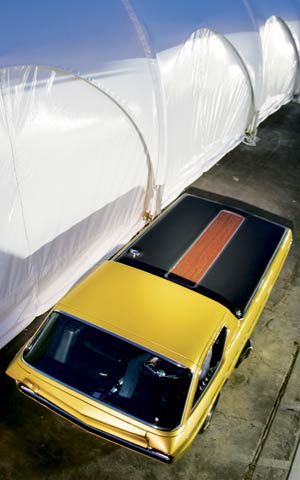
But if Chrysler wouldn't play, the Alexanders had a back-up plan: They would approach cross-town rival Ford, which had its own cab-over pickup, the Econoline. "Of the three cab-forward pickups on the market at the time, the Dodge was unquestionably the homeliest," Bradley recalls. "What I wanted to do was get rid of that phone-booth cab and integrate the upper with the lower," he says. There would be no doors. "I didn't want cutlines. We were always told at GM to play down cutlines. If cutlines were wonderful, Ferraris would have them running all down their sides. I always thought of it as a conceptual proposal, rather than a customizing solution." To actually get passengers inside, Bradley proposed a front-opening hatch built using the lift-up rear window from a 1960 Ford station wagon. Mike and Larry Alexander loved Bradley's proposal. Surprisingly, so did Chrysler, which handed over a stripped A100 to be chopped beyond recognition. The Alexanders cropped the stock cab sheetmetal right down to the floorpan. When the roof, the first of the new parts, was tacked in place, it nearly rested right on top of the stock steering column.

Bradley had originally intended the front hatch to be a top-hinged one-piece affair, like the tailgate of a modern hatchback or European sport wagon. But the narrow A-pillars just weren't strong enough to support it. The Alexander brothers instead developed a split-door arrangement, with the 1960 Ford window hinged at the top and controlled by an electric motor, and a handbuilt lower panel between the headlights that swung on a center pivot. C12 0509 Dodgedeora05 Z Engineering it all to work was every bit as complex as it sounds. In place of the stock steering column, the Alexanders fabricated a horizontal strut that rotated forward from the left body side--to allow the driver to get in and out--and locked into place when you wanted to drive. The steering wheel was a drag-racer-style butterfly item; steering inputs were transmitted via a sprocket and a chain running through the strut to a vertical shaft in the left body side.

Fortunately, the standard A100 pedals came through the floor, like those in a Porsche 911, and didn't have to be moved. Hurst engineers developed a special linkage to connect the floor-mounted shifter to the Chrysler three-speed manual transmission. To make room for occupants, the Alexanders moved the slant-six engine rearward 15 inches. It intruded well into the pickup bed, but as the Deora was never actually going to haul anything, it didn't matter. They also moved the radiator to the pickup bed and placed it ahead of the rear axle. Holes cut into the bottom of the bed allowed electric fans to draw through cooling air. It was a neat idea, but it meant the fuel tank had to be moved from its standard position behind the rear axle to the pickup bed just behind the cab.
To hide everything, the bed was covered with a hard tonneau secured by chrome hood-lock pins. C12 0509 Dodgedeora06 Z At its first public showing, the Deora caused a sensation, with Chrysler claiming it represented a major advance in modern vehicle styling. Even now, more than 40 years after it was first drawn, the Deora looks modern. Of course, it was designed in an era before crash tests and crumple zones, and that slammed cabin is a tight fit for most people. "The Alexanders were small guys," says Bradley. Those with a sharp eye for detail and a good memory will recognize a surprising number of Ford parts used on this "official" Chrysler custom. Apart from the 1960 Ford tailgate, the rear window is from a 1960 Ford sedan, and those side vents (for the exhausts) are actually 1964-1/2 Mustang taillight bezels. The ingenious taillights, hidden under the wood veneer panel across the rear and visible only when reflected in the angled chrome strip underneath, are the sequential turn-signal units from a Thunderbird. "Chrysler never seemed to understand we used Ford parts to build this car," says Bradley. Although driveable--"Mike and Larry's customs were always well engineered," says Bradley--Chrysler leased the car for a year to appear on its stand at car shows.

At the 1967 Detroit Autorama, one of the country's leading custom shows, the Deora won nine awards, including the coveted Ridler Award. In 1968, it became one of the 16 cars in the original Hot Wheels lineup when Bradley left GM to join Mattel. "At one stage, Mattel figured out that every kid in America had 1.3 Hot Wheels cars," says Bradley. That meant a lot of Deoras. "I don't think many knew it was a real vehicle." C12 0509 Dodgedeora07 Z Chrysler leased the Deora for a second year, but asked for changes, including a coat of lime green pearl paint. When the lease was not renewed at the end of the year, the Alexander brothers sold the Deora to custom-car enthusiast Al Davis, whose son, Al Jr., still owns it. Al Davis Sr. died in March 1970, and the Deora was put into storage. "I was 12 at the time," says Davis. "When I was 18 or 19, I pulled it out, restored it--though not to original condition--and put it back on the show circuit. I won a championship with it in 1982 and used the money as a down payment on a house." Davis pulled the Deora out of storage in 1998 and asked Harry Bradley to help restore it to its original 1967 look.
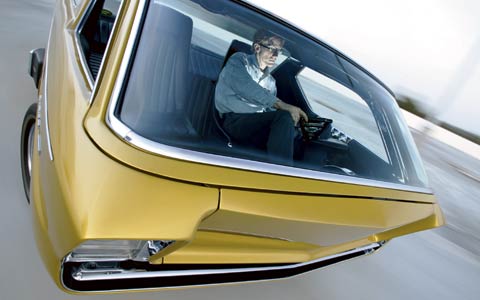
The color is greener than the original gold--Mike Alexander kept none of the original paint numbers--and Harry Bradley remade the exhaust boxes from templates supplied by Alexander so the Mustang taillight bezels could be refitted. As usual, the detail stuff took time to find, but the only pieces missing are the center console between the seats and the special Firestone tires made for it in the 1960s--the engineering drawings were rediscovered recently at Firestone, but the dies were destroyed years ago. C12 0509 Dodgedeora08 Z The Deora starred at the 50th-anniversary Detroit Autorama in 2002 as part of a special display of classic Alexander brothers customs. "The reaction was unbelievable." More than 40 years on, the Dodge Deora is still turning heads. Except one. To this day, the man who designed it, Harry Bentley Bradley, has never seen the finished truck and is in no hurry to do so. "Building a custom is more engrossing than owning one," he says. Detroit Copies VW
Words by Angus MacKenzie

Bradley was a regular contributor to the sketchpad pages of magazines that specialized in customizing, such as Rodding and Re-styling, Customs Illustrated, and Rod & Custom. Within weeks of his arrival at GM Design Staff in 1962, he and the Alexanders had forged a relationship that would result in more than 10 Bradley-designed custom cars over the next eight years. The Deora is the most famous by far. C12 0509 Dodgedeora04 Z The Deora project started in 1964 when the Detroit-based Alexander brothers decided they wanted to build a custom pickup based on one of Detroit's new cab-over pickups. They asked Harry Bradley to design a vehicle based on Chrysler's recently launched A100, figuring they'd get the company to supply them with a truck if they liked what they saw.

But if Chrysler wouldn't play, the Alexanders had a back-up plan: They would approach cross-town rival Ford, which had its own cab-over pickup, the Econoline. "Of the three cab-forward pickups on the market at the time, the Dodge was unquestionably the homeliest," Bradley recalls. "What I wanted to do was get rid of that phone-booth cab and integrate the upper with the lower," he says. There would be no doors. "I didn't want cutlines. We were always told at GM to play down cutlines. If cutlines were wonderful, Ferraris would have them running all down their sides. I always thought of it as a conceptual proposal, rather than a customizing solution." To actually get passengers inside, Bradley proposed a front-opening hatch built using the lift-up rear window from a 1960 Ford station wagon. Mike and Larry Alexander loved Bradley's proposal. Surprisingly, so did Chrysler, which handed over a stripped A100 to be chopped beyond recognition. The Alexanders cropped the stock cab sheetmetal right down to the floorpan. When the roof, the first of the new parts, was tacked in place, it nearly rested right on top of the stock steering column.

Bradley had originally intended the front hatch to be a top-hinged one-piece affair, like the tailgate of a modern hatchback or European sport wagon. But the narrow A-pillars just weren't strong enough to support it. The Alexander brothers instead developed a split-door arrangement, with the 1960 Ford window hinged at the top and controlled by an electric motor, and a handbuilt lower panel between the headlights that swung on a center pivot. C12 0509 Dodgedeora05 Z Engineering it all to work was every bit as complex as it sounds. In place of the stock steering column, the Alexanders fabricated a horizontal strut that rotated forward from the left body side--to allow the driver to get in and out--and locked into place when you wanted to drive. The steering wheel was a drag-racer-style butterfly item; steering inputs were transmitted via a sprocket and a chain running through the strut to a vertical shaft in the left body side.

Fortunately, the standard A100 pedals came through the floor, like those in a Porsche 911, and didn't have to be moved. Hurst engineers developed a special linkage to connect the floor-mounted shifter to the Chrysler three-speed manual transmission. To make room for occupants, the Alexanders moved the slant-six engine rearward 15 inches. It intruded well into the pickup bed, but as the Deora was never actually going to haul anything, it didn't matter. They also moved the radiator to the pickup bed and placed it ahead of the rear axle. Holes cut into the bottom of the bed allowed electric fans to draw through cooling air. It was a neat idea, but it meant the fuel tank had to be moved from its standard position behind the rear axle to the pickup bed just behind the cab.
To hide everything, the bed was covered with a hard tonneau secured by chrome hood-lock pins. C12 0509 Dodgedeora06 Z At its first public showing, the Deora caused a sensation, with Chrysler claiming it represented a major advance in modern vehicle styling. Even now, more than 40 years after it was first drawn, the Deora looks modern. Of course, it was designed in an era before crash tests and crumple zones, and that slammed cabin is a tight fit for most people. "The Alexanders were small guys," says Bradley. Those with a sharp eye for detail and a good memory will recognize a surprising number of Ford parts used on this "official" Chrysler custom. Apart from the 1960 Ford tailgate, the rear window is from a 1960 Ford sedan, and those side vents (for the exhausts) are actually 1964-1/2 Mustang taillight bezels. The ingenious taillights, hidden under the wood veneer panel across the rear and visible only when reflected in the angled chrome strip underneath, are the sequential turn-signal units from a Thunderbird. "Chrysler never seemed to understand we used Ford parts to build this car," says Bradley. Although driveable--"Mike and Larry's customs were always well engineered," says Bradley--Chrysler leased the car for a year to appear on its stand at car shows.

At the 1967 Detroit Autorama, one of the country's leading custom shows, the Deora won nine awards, including the coveted Ridler Award. In 1968, it became one of the 16 cars in the original Hot Wheels lineup when Bradley left GM to join Mattel. "At one stage, Mattel figured out that every kid in America had 1.3 Hot Wheels cars," says Bradley. That meant a lot of Deoras. "I don't think many knew it was a real vehicle." C12 0509 Dodgedeora07 Z Chrysler leased the Deora for a second year, but asked for changes, including a coat of lime green pearl paint. When the lease was not renewed at the end of the year, the Alexander brothers sold the Deora to custom-car enthusiast Al Davis, whose son, Al Jr., still owns it. Al Davis Sr. died in March 1970, and the Deora was put into storage. "I was 12 at the time," says Davis. "When I was 18 or 19, I pulled it out, restored it--though not to original condition--and put it back on the show circuit. I won a championship with it in 1982 and used the money as a down payment on a house." Davis pulled the Deora out of storage in 1998 and asked Harry Bradley to help restore it to its original 1967 look.

The color is greener than the original gold--Mike Alexander kept none of the original paint numbers--and Harry Bradley remade the exhaust boxes from templates supplied by Alexander so the Mustang taillight bezels could be refitted. As usual, the detail stuff took time to find, but the only pieces missing are the center console between the seats and the special Firestone tires made for it in the 1960s--the engineering drawings were rediscovered recently at Firestone, but the dies were destroyed years ago. C12 0509 Dodgedeora08 Z The Deora starred at the 50th-anniversary Detroit Autorama in 2002 as part of a special display of classic Alexander brothers customs. "The reaction was unbelievable." More than 40 years on, the Dodge Deora is still turning heads. Except one. To this day, the man who designed it, Harry Bentley Bradley, has never seen the finished truck and is in no hurry to do so. "Building a custom is more engrossing than owning one," he says. Detroit Copies VW
Words by Angus MacKenzie
Dernière édition par Predicta le Mer 17 Déc - 9:57, édité 1 fois
_________________
We don't care the People Says , Rock 'n' roll is here to stay - Danny & the Juniors - 1958
 Re: The Deora - Alexander Brothers
Re: The Deora - Alexander Brothers
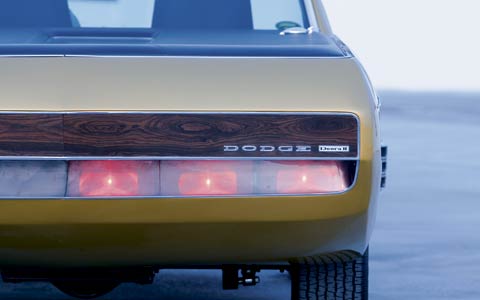
The Dodge A100 was the last in a string of smallish, forward-control pickups launched by Detroit automakers around this time--Jeep had kicked off the vogue in 1956 with the launch of its 4WD Willys FC-150 styled by Brooks Stevens; Ford had followed with the Econoline. GM, most radically of all, used Corvair running gear to produce the rear-engine Chevy Loadside and Rampside pickups, trucks whose layout most closely resembled the inspiration for all these vehicles, VW's Transporter pickup. Although the A100's power--it used Chrysler's 170- and 225-cubic-inch slant-six engines, mounted between the front seats--and its interior package were perhaps the best of the bunch, consumers' enthusiasm for forward-control trucks lagged behind that of the automakers by the time it launched for 1964. Chevy had already killed off its Corvair-powered pickups, and Econoline pickup sales were slow. Ford axed the Econoline pickup after 1967; the A100 lasted barely two years more.
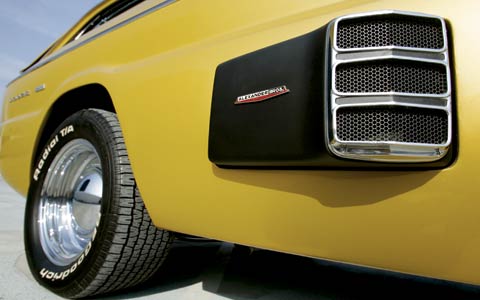
Read more: http://www.motortrend.com/classic/roadtests/c12_0509_dodge_deora/#ixzz3M99h7ogC




_________________
We don't care the People Says , Rock 'n' roll is here to stay - Danny & the Juniors - 1958
 Re: The Deora - Alexander Brothers
Re: The Deora - Alexander Brothers

This year marks the 61st anniversary of the Detroit Autorama, and when it comes to indoor custom car shows, this is the granddaddy of them all. Over the past six decades, iconic street rods and customs have left an indelible mark on the minds of car enthusiasts as they gazed at the candy apple metallic paint jobs, chrome wheels and fat tires.
Of all the cars that have been on display at the Detroit Autorama, the one that probably stands out the most among Dodge enthusiasts is the Deora. This infamous show car dazzled onlookers and inspired a generation of automotive designers and custom car builders. It was also one of the first custom cars to be successfully marketed to children through various toy companies. How it ended being named the “Deora” was a great marketing strategy by a model car company, and we’ll get to that in a moment.
Based on a 1965 Dodge A100 compact pickup truck, the Deora was heavily modified by a Detroit-based custom house run by two brothers. The A100’s roofline was chopped, while the body was sectioned and channeled. One of the neat features of the Deora was the front windshield that would lift up and the lower gate would swivel, allowing the driver/passenger access into the car through the front of the cab. The result was a futuristic-looking pickup that looked like it came out of a scene from the Jetsons.
Despite its 21st century looks, which would’ve been considered light years away in 1967, it was powered with a basically stock slant-six engine and a three-speed manual transmission, which were moved rearward 15 inches to allow for the severely customized cab. The bed was covered with a hard tonneau cover and the truck was emblazoned in gold paint complemented by chrome wheels while the interior featured some pretty trick modifications for the era.
Because of its outrageous design, a major plastic model car company and a diecast toy manufacturer offered scaled-down versions for sale to the growing youth market. To help promote the launch of the model version, the model car company ran a naming contest, and it was a 13-year-old who came up with the name “Deora.” Loosely translated, it’s Spanish for “golden.” Other toy manufacturers quickly offered miniature versions of the Deora in plastic and metal, and soon it was one of the hottest-selling toy cars of the late 1960s.
The Deora made its public debut at the 1967 Detroit Autorama and won the prestigious Ridler award that recognizes the skill and creativity of custom cars and their builders within the industry. It also caught the attention of the Chrysler marketing folks who really loved the look of the Deora. They leased it for two years and put it on tour going around the United States with other factory concept cars to complement the Dodge displays at the new car shows during the late 1960s.
After its tour of duty on the show circuit, the Deora was sold and put in storage for more than 30 years. Finally, after a light restoration, the Deora reappeared and made its “second debut” at the 50th anniversary Detroit Autorama in 2002.
Now, 11 years later, enthusiasts young and old will once again see one of the few surviving Dodge show vehicles that toured the country during the 1960s, as the Deora will be on display during this weekend’s 61st annual Detroit Autorama.
http://blog.dodge.com/events/the-dodge-deora/
_________________
We don't care the People Says , Rock 'n' roll is here to stay - Danny & the Juniors - 1958
 Re: The Deora - Alexander Brothers
Re: The Deora - Alexander Brothers

One of the "First 16" Hot Wheels in 1968, the Deora is a customized "surfer truck" designed by Mattel's first Hot Wheels designer, Harry Bentley Bradley.
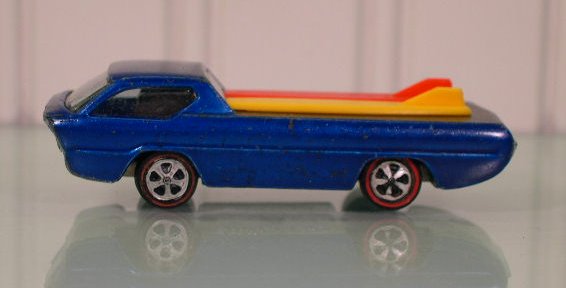
Interestingly, in 1964 Bradley designed the real Dodge Deora in collaboration with the Alexander brothers. The prototype vehicle used the A100 pickup, and incorporated parts of a 1960 Ford wagon and a sedan for the distinctive roofline. Using Bradley's preferred moniker of the Dodge XTAB (eXperimental Truck by the Alexander Brothers), the design was created for Chrysler.

Nearing completion on the project, model kit-producer AMT requested permission to produce a model based on the truck. But what to call it? The XTAB, while an adequate internal name, was just that. Both AMT and Chrysler wanted a better name for the truck.

Seeing opportunity, someone suggested a marketing ploy that would spur interest in the new kit: a contest where model-builders could send in possible names for the custom truck, and entries would be reviewed by a panel of celebrity judges. The deal was struck and an ad calling for entries ran in the September 1965 issue of "Car Model" magazine, accompanied by Bradley's renderings and in-progress photos of the project.

A panel of judges was made up of Chrysler's quarter-miler Don Garlits, Auto World's Oscar Koveleski, "Car Model" magazine Co-Publisher Bob MacLeod, AMT's Director of Marketing Len Bolton, and of course the Alexander brothers. The contest results were announced in the February 1966 issue of "Car Model".
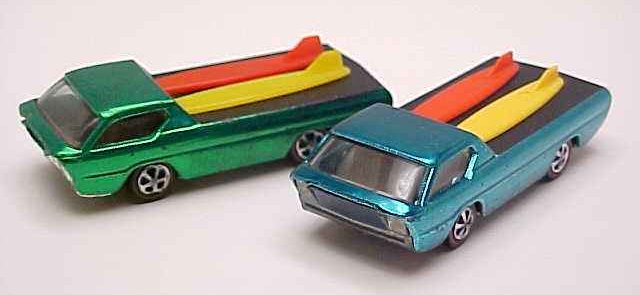
Thirteen-year-old David Hagedorn's entry topped all the others. It was short and suitably exotic: DEORA. David explained that it meant "golden" in Spanish (which is slightly incorrect; "de oro" is Spanish for "of gold"). Since Bradley's original plan called for finishing the project in gold, the name was perfect! David was rewarded with the first AMT Deora kit!

When Bradley signed on to be Mattel's first designer, he brought the Deora with him. Elliot Handler's idea for adding two surfboards to the otherwise plain bed of the pickup gave the casting the "California Custom" look that Mattel was seeking for its new line of diecast toy cars.

http://onlineredlineguide.com/68/68_deora/68_deora.html
_________________
We don't care the People Says , Rock 'n' roll is here to stay - Danny & the Juniors - 1958
 Re: The Deora - Alexander Brothers
Re: The Deora - Alexander Brothers
_________________
We don't care the People Says , Rock 'n' roll is here to stay - Danny & the Juniors - 1958
 Re: The Deora - Alexander Brothers
Re: The Deora - Alexander Brothers
The Deora is a 1965 Dodge A100 pickup truck that was heavily customized by Mike and Larry Alexander in Detroit for the 1967 Detroit Autorama. After winning many awards, including the highly-prestigious Ridler in 1967, it became the prototype for a Hot Wheels car, and plastic model kit. Sold at auction in 2009 for $230,000.

Design
The Alexander brothers commissioned the design from Harry Bentley Bradley in 1964. It was unveiled in their home town during the Detroit Autorama in 1967, where it won nine awards including the Ridler Award. The Deora is based on the compact Dodge A100 pickup.[2] The back hatch of a 1960 Ford station wagon served as the windshield. It was chopped, sectioned, and channeled to create the fully functional, futuristic-looking pickup. The slant six engine and 3-speed manual transmission were moved rearward 15 inches, out of the cab and into the bed and covered by the hard tonnueau. Entrance into the gold painted custom is achieved by lifting up the windshield, swivelling the lower gate and entering through the front.

After a naming contest run by AMT model cars. it was called the Deora. Harry Bradley had proposed to call it XTAB (standing for eXperimental Truck Alexander Brothers).[3] The winning entry was from a 13-year-old boy, and is a technically incorrect version of the Spanish word for “golden”.[4]

Chrysler liked the resulting truck so well that they leased it for two years to display with their other factory concept cars. It was then put into storage after being sold to Al Davis. His son took the Deora out of storage in 1998 and Harry Bradley was asked to help restore it. The finished restoration took part in the 50th-anniversary Detroit Autorama in 2002 as part of a special display of classic Alexander brothers customs.
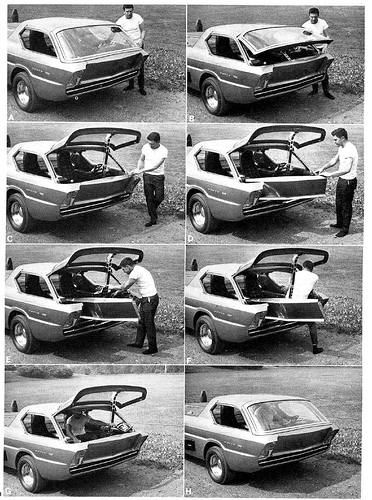
In 2009 the Deora was put up for auction in California and was sold for $324,500. It was described as featuring a 101 bhp (75 kW; 102 PS) 6-cylinder 170 cu in (2,800 cc) engine.[5]
Hot Wheels

The Deora is also a major player in Hot Wheels history. It was part of the very first Hot Wheels line in 1968. In 2000, Hot Wheels released the Deora II, an update of the original.

Three years later, in preparation for Hot Wheels' 35th anniversary, a full size Deora II was unveiled. It was built by Chip Foose and 5-axis, and sports a Cadillac Northstar V8 engine.[6]
http://en.wikipedia.org/wiki/Deora_%28custom_car%29

Design
The Alexander brothers commissioned the design from Harry Bentley Bradley in 1964. It was unveiled in their home town during the Detroit Autorama in 1967, where it won nine awards including the Ridler Award. The Deora is based on the compact Dodge A100 pickup.[2] The back hatch of a 1960 Ford station wagon served as the windshield. It was chopped, sectioned, and channeled to create the fully functional, futuristic-looking pickup. The slant six engine and 3-speed manual transmission were moved rearward 15 inches, out of the cab and into the bed and covered by the hard tonnueau. Entrance into the gold painted custom is achieved by lifting up the windshield, swivelling the lower gate and entering through the front.

After a naming contest run by AMT model cars. it was called the Deora. Harry Bradley had proposed to call it XTAB (standing for eXperimental Truck Alexander Brothers).[3] The winning entry was from a 13-year-old boy, and is a technically incorrect version of the Spanish word for “golden”.[4]

Chrysler liked the resulting truck so well that they leased it for two years to display with their other factory concept cars. It was then put into storage after being sold to Al Davis. His son took the Deora out of storage in 1998 and Harry Bradley was asked to help restore it. The finished restoration took part in the 50th-anniversary Detroit Autorama in 2002 as part of a special display of classic Alexander brothers customs.

In 2009 the Deora was put up for auction in California and was sold for $324,500. It was described as featuring a 101 bhp (75 kW; 102 PS) 6-cylinder 170 cu in (2,800 cc) engine.[5]
Hot Wheels

The Deora is also a major player in Hot Wheels history. It was part of the very first Hot Wheels line in 1968. In 2000, Hot Wheels released the Deora II, an update of the original.

Three years later, in preparation for Hot Wheels' 35th anniversary, a full size Deora II was unveiled. It was built by Chip Foose and 5-axis, and sports a Cadillac Northstar V8 engine.[6]
http://en.wikipedia.org/wiki/Deora_%28custom_car%29
_________________
We don't care the People Says , Rock 'n' roll is here to stay - Danny & the Juniors - 1958
 Re: The Deora - Alexander Brothers
Re: The Deora - Alexander Brothers
_________________
We don't care the People Says , Rock 'n' roll is here to stay - Danny & the Juniors - 1958
 Re: The Deora - Alexander Brothers
Re: The Deora - Alexander Brothers
_________________
We don't care the People Says , Rock 'n' roll is here to stay - Danny & the Juniors - 1958
 Re: The Deora - Alexander Brothers
Re: The Deora - Alexander Brothers
_________________
We don't care the People Says , Rock 'n' roll is here to stay - Danny & the Juniors - 1958
 Sujets similaires
Sujets similaires» Deora - Dodge custom - Alexander Brothers
» Deora Custom show rod - Alexander Brothers - Hot Wheels
» Deora Dodge Concept custom car - Alexander Brothers - 100% Hot Wheels Collectibles
» Deora - Alexander Brother's Show car - MPC
» Ford 1960 custom & mild custom
» Deora Custom show rod - Alexander Brothers - Hot Wheels
» Deora Dodge Concept custom car - Alexander Brothers - 100% Hot Wheels Collectibles
» Deora - Alexander Brother's Show car - MPC
» Ford 1960 custom & mild custom
Permission de ce forum:
Vous ne pouvez pas répondre aux sujets dans ce forum
 Connexion
Connexion




